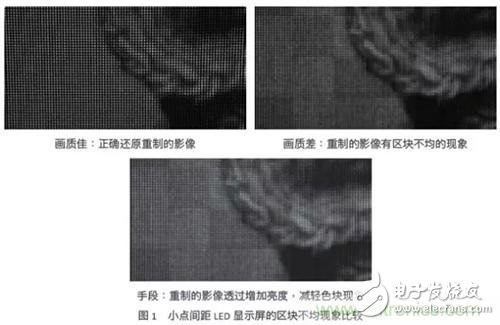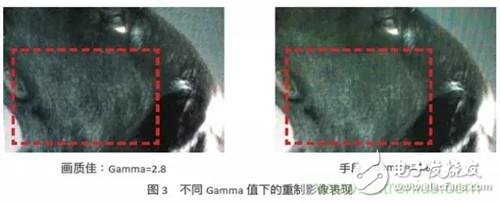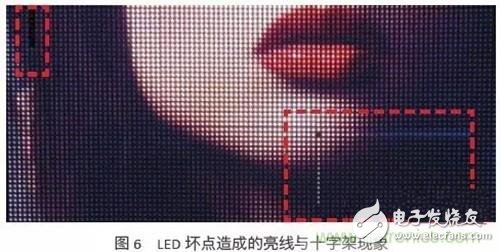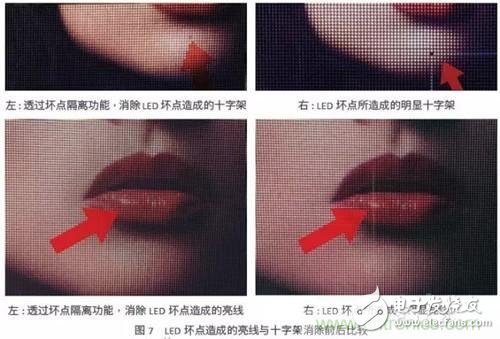In addition to LEDs, LED driver chips are also an important part for small-pitch LED displays, although many vendors claim that their LED driver chips are designed for small-pitch LED displays, but in fact they Some means still need to be used to cover up some of the defects. The following will introduce the truth and means of disguising the poor display effect when the small-pitch LED display uses an inappropriate driver chip.
1. Block unevenness and color shift (reddish)
In indoor applications, the brightness of the LED display is between 300 and 1000 nits. This brightness is converted into LED forward current, which is about 1~5mA or even less than 1mA. Therefore, the small current concentration of the driving chip becomes important. When the current accuracy of the driving chip is not good, the small-pitch LED display screen is prone to uneven color blocks. However, in order to disguise the color block, the LED current is usually used to increase the brightness of the display. However, the disadvantage is that when the viewer looks at the LED display for a while, the eyes are prone to discomfort. Figure 1 demonstrates the actual difference after re-imaging the image with a small-pitch LED display that uses different quality LED driver chips.

Proportionally, the forward current of green and blue LEDs is more affected by parasitic capacitance than red LEDs, so at low gray levels, the small dot pitch LED display looks reddish (red-TInt). It is the color shift we often say, as shown in Figure 2. The correct solution is to use LED driver chips with color-shift compensation instead of masking this shortcoming by increasing the LED forward current.

2. Loss of image detail at low brightness
If you do not use the way to improve the forward current of the LED to cover the above shortcomings, another way is to adjust the gamma curve of the LED display with small dot spacing. The brightness of the grayscale is very important for correct image reproduction because in the video source. The medium brightness contains most of the picture data. As shown in Fig. 3, the image on the right has a small gamma value, which means that the brightness of the midtone is too high. Therefore, the overall picture is white and lacks depth, and the detail loss on the image is quite small. Compared with the left picture, the dog hair in the right picture does not. Then there are levels.

3. Unsmooth grayscale performance
The small dot pitch LED display is a mulTIplexed display and a non-liquid crystal display hold-type display, so the refresh rate is quite important for small dot pitch LED displays, and the lower refresh rate will not only make small The dot-pitch LED display has a flickering discomfort, which is easy to cause the viewer to faint, and the grayscale gradient effect is not smooth. Taking Figure 4 as an example, the grayscale gradation effect of the face on the right is not smoother than that of the left image, and there is a phenomenon similar to the contour line. From the grayscale gradation test screen of Fig. 5, the small dot of the right image can also be seen. The continuity of the pitch LED display is worse than that of the left image.

4. Bright lines or crosses caused by LED dead spots
Today's LED epitaxial and packaging technology is increasing day by day, but LEDs will inevitably be damaged after a long period of use. Unlike LCD screens, broken LEDs will form bright lines or crosses at small dot-pitch LED displays. Instead of a black dot, as shown in Figure 6. It is a big problem for LED display manufacturers, operators and viewers.

A good small dot pitch LED display must be able to eliminate the annoying bright lines or crosses caused by LED dead spots, as shown in the left figure of Figure 7. Only the LED driver chip with "dead pixel isolaTIon" function can maintain the normal operation of the LED display with small dot spacing, and it is convenient for the user to flexibly arrange the maintenance time.

The above methods are very common in small-pitch LED displays, but limited by the knowledge and ability of buyers and users for basic image processing and LED driver chips, it is not easy to distinguish these differences and avoid the above annoying problems. The easiest way is to choose an LED driver chip designed for LED display with small dot pitch.
Electronic Cigarette,Vape Electronic Cigarette Disposable,Pre-Charge Use Electronic Atomizer,Disposable Electronic Cigarettes
Jinhu Weibao Trading Co., Ltd , https://www.weibaoe-cigarette.com